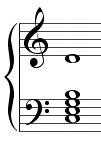Ninth: Difference between revisions
In the common practice period, "the root, 3rd, 7th, and 9th are the most common factors present in the V<sup>9</sup> chord," with the 5th, "typically omitted".<ref name="B&S 183-84">Benward & Sake |
|||
| Line 12: | Line 12: | ||
A '''ninth chord''' or '''dominant ninth''' is a [[chord (music)|chord]] or [[dominant (music)|dominant chord]] with a ninth, and as an [[extended chord]] typically includes the seventh along with the basic triad structure. Thus, a Cmaj9 consists of C E G B and D {{Audio|Maj ninth chord on C.mid|play}}. When the symbol "9" is not preceded by the word "major" or "maj", the implied seventh is a minor seventh -- e.g. a C9 consists of C E G B{{music|flat}} and D {{Audio|Dominant ninth chord on C.mid|play}}, and would usually be expected to resolve into a chord of F major (the implied key, C being the dominant of F). |
A '''ninth chord''' or '''dominant ninth''' is a [[chord (music)|chord]] or [[dominant (music)|dominant chord]] with a ninth, and as an [[extended chord]] typically includes the seventh along with the basic triad structure. Thus, a Cmaj9 consists of C E G B and D {{Audio|Maj ninth chord on C.mid|play}}. When the symbol "9" is not preceded by the word "major" or "maj", the implied seventh is a minor seventh -- e.g. a C9 consists of C E G B{{music|flat}} and D {{Audio|Dominant ninth chord on C.mid|play}}, and would usually be expected to resolve into a chord of F major (the implied key, C being the dominant of F). |
||
[[Image:Ninth chord voice leading.png|thumb|Voice leading for dominant ninth chords in the common practice period.<ref name="B&S 183-84"/> {{Audio|Ninth chord voice leading.mid|Play}}]] |
|||
In the [[common practice period]], "the root, 3rd, 7th, and 9th are the most common factors present in the V<sup>9</sup> chord," with the 5th, "typically omitted".<ref name="B&S 183-84">Benward & Saker (2009). Music in Theory and Practice: Volume II, p.183-84. Eighth Edition. ISBN 978-0-07-310188-0.</ref> The 9th and 7th usually resolve downward to the 5th and 3rd of I.<ref name="B&S 183-84"/> |
|||
[[Image:Ninth chord CMI9 chord.png|thumb|Cmi9 chord {{Audio|Ninth chord CMI9 chord.mid|Play}}]] |
[[Image:Ninth chord CMI9 chord.png|thumb|Cmi9 chord {{Audio|Ninth chord CMI9 chord.mid|Play}}]] |
||
| Line 23: | Line 27: | ||
==See also== |
==See also== |
||
*[[Jazz chord]] |
*[[Jazz chord]] |
||
==Sources== |
|||
{{reflist}} |
|||
{{Chords}} |
{{Chords}} |
||
Revision as of 06:34, 8 July 2009

In music or music theory a ninth is the note nine scale degrees from the root of chord (counting the root itself) and also the interval between the root and the ninth. ⓘ as would occur between the first and transposed second degrees of a major scale.

In tonal music of common practice, the interval of a ninth is heard as a dissonance. A ninth is a compound second, but the ninth is considered less dissonant than the second.

A ninth chord or dominant ninth is a chord or dominant chord with a ninth, and as an extended chord typically includes the seventh along with the basic triad structure. Thus, a Cmaj9 consists of C E G B and D ⓘ. When the symbol "9" is not preceded by the word "major" or "maj", the implied seventh is a minor seventh -- e.g. a C9 consists of C E G B♭ and D ⓘ, and would usually be expected to resolve into a chord of F major (the implied key, C being the dominant of F).

In the common practice period, "the root, 3rd, 7th, and 9th are the most common factors present in the V9 chord," with the 5th, "typically omitted".[1] The 9th and 7th usually resolve downward to the 5th and 3rd of I.[1]

The minor ninth chord is played with the third and seventh both flattened. The formula is 1, ♭3, 5, ♭7, 9. This chord is written as Cm9. This chord has a more "bluesy" sound and fits very well with the dominant 9th.
An added ninth chord is a major triad with an added ninth. Thus, Cadd9 consists of C E G and D. (The D, which might be called an added second, is two fifths up from the root.) Added ninth chords differ from other ninth chords because the seventh is not included.
The Hendrix chord uses a sharpened ninth. This is, enharmonically, the flatted third, and is tonally ambiguous or bitonal.

